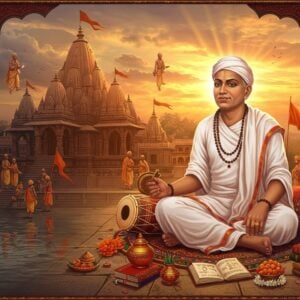
Delve into the intricate world of Indian painting, deeply rooted in ancient traditions and cultural practices. Indian art transcends mere aesthetics; it’s a spiritual and philosophical exploration. This article explores the Six Limbs of Indian Painting, known as ‘Shadanga,’ the foundational principles guiding traditional Indian artwork creation. These principles, outlined in ancient texts, have influenced Indian art for centuries.
Understanding ‘Shadanga’
‘Shadanga‘ originates from the Sanskrit words ‘Shad‘ (six) and ‘Anga‘ (limbs). These six limbs are guidelines for harmonious composition in Indian painting. First mentioned in the ‘Vishnudharmottara Purana,’ an ancient text offering insights into art’s technical and spiritual aspects, these limbs provide a detailed framework for the creation and evaluation of art, emphasizing both technical prowess and aesthetic depth. These principles ensure that Indian paintings maintain their cultural richness while expressing beauty and depth.
- Rupabheda (रूपभेदः): Knowledge of appearances and distinctions of forms. It enables an artist to perceive and depict things as they appear. It stresses the physical typologies of form and the knowledge of the subtle differences between forms, allowing artists to capture the unique essence of each element.
- Pramana (प्रमाणानि): Correct perception, measure, proportion, and structure. It teaches the exact measure, proportion, and distance of the subjects and provides insight into the structural anatomy of subjects. In Indian art, प्रमाण (Proportion) is taken in two parts: physical proportion and mental proportion, creating balance and harmony within the artwork.
- Bhava (भाव): Expression and emotion. It is the expression of inner beauty and eulogizes the expression of emotions, enabling artists to convey depth and meaning through their work.
- Lavanya Yojanam (लावण्ययोजनम्): Infusion of grace and artistic representation. It enhances the beauty and grace of artifacts, breathing life into the artwork and inviting viewers to connect with its elegance.
- Sadrisyam (सादृश्यं): Similitude or achieving credible resemblance to reality. It is the depiction that is similar to an artist’s vision or the subject itself, capturing the true essence of the subject while maintaining artistic integrity.
- Varnika Bhangam (वर्णिकाभंग): Knowledge of color scheme. It conveys the knowledge of color application, mixing, and the psychological effects of color to create an aesthetic sense, allowing artists to evoke specific moods and emotions through their color choices.
Rupabheda – Distinguishing Forms
Rupabheda emphasizes distinguishing various forms in a painting. This ensures each element retains its unique identity while contributing to the overall composition. Artists achieve this through line, shape, and contour, clearly depicting figures, objects, and scenes, crucial for viewer understanding and appreciation of the narrative.
Pramana – Proportion and Harmony
Pramana refers to the proper proportion and measurement of elements within a painting. Ensuring each component is accurately represented in relation to others maintains balance and harmony. Influenced by mathematical precision in Indian architecture and sculpture, artists use grids and guidelines to achieve desired proportions, creating aesthetically pleasing and structurally sound artwork.
Bhava – Capturing Emotion
Bhava captures emotion and expression’s essence, central to Indian painting. It conveys the intended mood through facial expressions, postures, and gestures, allowing viewers to connect emotionally, transcending the visual experience. Artists meticulously study human emotions for authenticity in their depictions.
Lavanya Yojanam – The Essence of Grace
Lavanya Yojanam highlights the grace and elegance within a painting. Artists create grace through gentle lines and flowing forms, bringing life and vitality. This element invites viewers to feel the movement and rhythm, like a classical dance on canvas, each stroke breathing life. This gracefulness is a divine reflection, elevating the artwork.
Sadrisyam – Achieving Likeness
Sadrisyam ensures paintings accurately represent their subjects within the Indian artistic style. Balancing realism with traditional ideals, artists capture the essence of people, deities, or nature. This likeness connects viewers, recognizing familiar forms and stories. Artists strive for authentic depictions, making their art relatable and engaging.
Varnikabhanga – The Power of Color
Varnikabhanga emphasizes color’s impact, enhancing a painting’s effect. Artists carefully select pigments for depth and harmony. Colors hold symbolic meaning, reflecting cultural themes, telling stories of tradition, spirituality, and emotion. Skillful blending breathes life into the artwork, inviting viewers to experience its vibrancy and meaning.
Indian painting is a tapestry of tradition and emotion, each brushstroke guided by ancient principles, bringing life to art transcending visuals, offering a glimpse into India’s rich heritage. Each Shadanga limb contributes to this timeless beauty, creating art that speaks to the soul. Explore the beauty of Laddu Gopal and other deities through the lens of Shadanga.
How Poojn.in Supports Your Artistic and Spiritual Journey
Poojn.in offers a wide selection of products that can enrich your artistic endeavors and spiritual practices:
- For Rupabheda (form): High-quality brass Laddu Gopal murtis and other deity statues can serve as inspiration and models for your artistic creations. Explore the many forms of Lord Ganesha for further artistic inspiration.
- For Bhava (expression): Find a wide array of Tulsi kanthi malas and other sacred items that can deepen your spiritual practice and understanding of divine expression. Enhance your knowledge of Goddess Lakshmi and other deities.
- For Varnikabhanga (color theory): Pooja items like Arjun chal can be used to create natural pigments, connecting your art with tradition. Find the perfect Ganesh Chaturthi rangoli designs to deepen your artistic and spiritual connection.
Visit Poojn.in to explore our complete collection of art supplies, puja items, and religious items that support traditional Indian sacred art practices. All items are verified for authenticity and religious appropriateness.
Conclusion: A Timeless Legacy
The six limbs of Indian painting aren’t mere techniques; they’re a celebration of art and tradition. Lavanya Yojanam, Sadrisyam, and Varnikabhanga are vital, weaving grace, likeness, and color into each piece, helping artists express stories, emotions, and India’s rich heritage. Appreciating these paintings connects us with the past, finding meaning in the present. Indian art’s timeless beauty invites exploration, learning, and cherishing traditions shaping our world. We see art not just with our eyes but with our hearts, understanding its soul and spirit.
FAQs on Shadanga: Deeper Insights
What are the Six Limbs of Indian Painting?
The Six Limbs, or Shadanga, are guidelines describing traditional Indian art elements: Rupabheda (form distinction), Pramana (proportion), Bhava (emotion), Lavanya Yojanam (graceful composition), Sadrisyam (likeness), and Varnikabhanga (color application).
Why are the Six Limbs important?
These limbs provide a foundational framework for harmonious, balanced paintings, helping artists achieve desired expression and aesthetic beauty. They offer a structured approach to creating art that resonates with both the artist and the viewer.
How does Rupabheda influence Indian painting?
Rupabheda, or form distinction, ensures clear and distinguishable depictions of various forms. This clarity allows for easy recognition of the painting’s subject and enhances the overall impact of the artwork.


